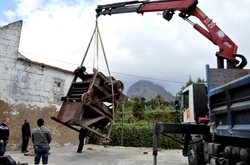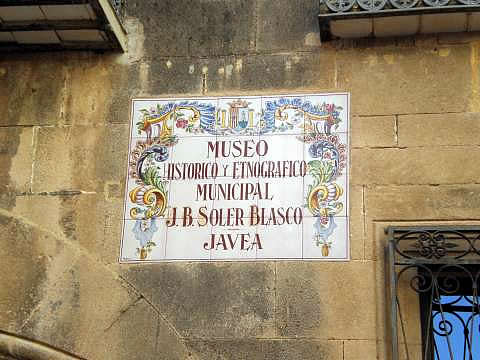An antique machine for grading raisins has been donated to the Soler Blasco Museum in Jávea24/3/2014  This agricultural implement will be installed as part of the information display in the Riurau d’Arnauda Jávea, Thursday, 20th March 2014. The Soler Blasco Municipal Archaeology and Ethnographic Museum in Jávea has now added to its collection an antique piece of machinery originally used for grading raisins; the machine is an ingenious construction of wood and iron, measuring 294 by 180 cms wide and about 3 mtrs in height. This interesting and culturally valuable piece of equipment constitutes one of the last examples of its type still preserved in our region and has been donated by Agrogata SL, a descendent of the old CAS company (Union of Agricultural Cooperatives), established back in 1960. According to the spokesman at the Museum, the machine will now be cleaned and tidied up before being installed as part of the informative display about raisin production located in the Riurau de los Català d’Arnauda situated in the Montaner park. This special agricultural implement was constructed during the first few decades of the 20th century in the Borrell workshops in Denia and was used for various different purposes involved in the processing of raisins. Most recently the machine was used for stripping the stalks from clusters of raisins. However, it also has several interchangeable rectangular shaped screens used for the selection and grading of the raisins. The way it works is very simple: the raisins (loose or in bunches) were poured into a hopper at the top of the machine into a cylinder from where they dropped through some large rectangular screens which collected them and separated the stalks from the raisins. The mechanism was powered by an electric motor, which may have originally been steam driven, and which functioned with a rotary action, vibrating the sieves on the machine by means of straps and wooden wheels.
0 Comments
|
ACTIVITIES
Categories |
- Home
- Blogs
-
Projectes
- Premio de Investigación - Formularios de Inscripción
-
Traducciones Translations
>
-
DISPLAY PANELS - GROUND FLOOR
>
- THE STONE AGES - PALAEOLITHIC, EPIPALAEOLITHIC AND NEOLITHIC
- CAVE PAINTINGS (ARTE RUPESTRE)
- CHALCOLITHIC (Copper) & BRONZE AGES
- THE IBERIAN CULTURE (THE IRON AGE)
- THE IBERIAN TREASURE OF XÀBIA
- THE ROMAN SETTLEMENTS OF XÀBIA
- THE ROMAN SITE AT PUNTA DE L'ARENAL
- THE MUNTANYAR NECROPOLIS
- ARCHITECTURAL DECORATIONS OF THE PUNTA DE L'ARENAL
- THE ATZÚBIA SITE
- THE MINYANA SMITHY
- Translations archive
- Quaderns: Versión castellana >
- Quaderns: English versions >
-
DISPLAY PANELS - GROUND FLOOR
>
- Catálogo de castillos regionales >
- Exposició - Castells Andalusins >
- Exposición - Castillos Andalusíes >
- Exhibition - Islamic castles >
- Sylvia A. Schofield - Libros donados
- Mejorar la entrada/improve the entrance >
-
Historia y enlaces
-
Historía de Xàbia
>
- Els papers de l'arxiu, Xàbia / los papeles del archivo
- La Cova del Barranc del Migdia
- El Vell Cementeri de Xàbia
- El Torpedinament del Vapor Germanine
- El Saladar i les Salines
- La Telegrafía y la Casa de Cable
- Pescadores de Xàbia
- La Caseta de Biot
- Castell de la Granadella
- La Guerra Civil / the Spanish civil war >
- History of Xàbia (English articles) >
- Charlas y excursiones / talks and excursions >
- Investigacions del museu - Museum investigations
- Enllaços
- Enlaces
- Links
-
Historía de Xàbia
>
- Social media
- Visitas virtuales
- Tenda Tienda Shop


 RSS Feed
RSS Feed
